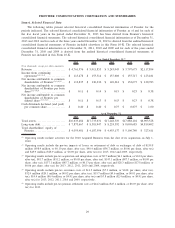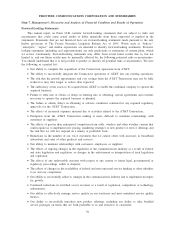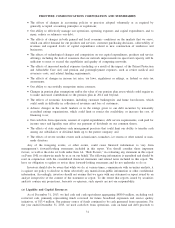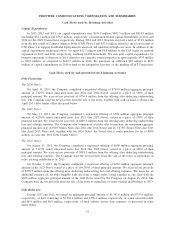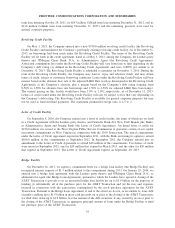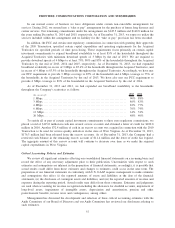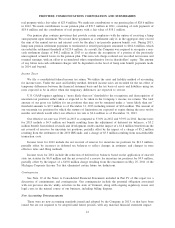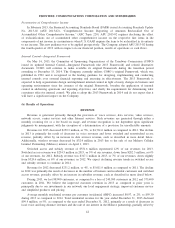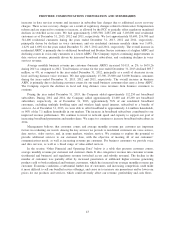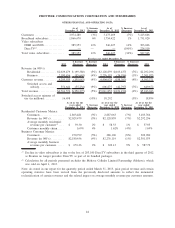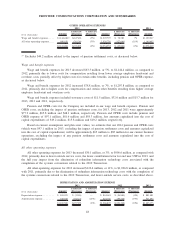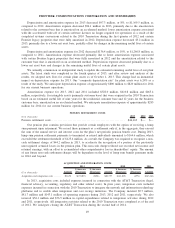Frontier Communications 2013 Annual Report Download - page 40
Download and view the complete annual report
Please find page 40 of the 2013 Frontier Communications annual report below. You can navigate through the pages in the report by either clicking on the pages listed below, or by using the keyword search tool below to find specific information within the annual report.
Goodwill by reporting unit (operating segment) at December 31, 2013 is as follows:
($ in thousands) 2013
Central .................................................................. $1,815,498
East..................................................................... 2,003,574
National. . . .............................................................. 1,218,113
West .................................................................... 1,300,534
Total Goodwill. ..................................................... $6,337,719
Enterprise values for rural ILEC properties are typically quoted as a multiple of cash flow or EBITDA.
Marketplace company comparisons and analyst reports support a range of fair values around a multiple of 5.5
to 7.5 times annualized EBITDA. For the purpose of the goodwill impairment test we define EBITDA as
operating income, net of acquisition and integration costs, non-cash pension and OPEB costs, pension
settlement costs, gain on sale of Mohave partnership interest and severance costs, plus depreciation and
amortization. We determined the fair value estimates using 6.25 times EBITDA but also used lower EBITDA
multiples to gauge the sensitivity of the estimate and its effect on the margin of excess of fair value over the
carrying values of the reporting units. Total fair value determined in this manner is then allocated to the
reporting units based upon each unit’s relative share of consolidated EBITDA. Our method of determining fair
value has been consistently applied for the three years ending December 31, 2013.
The Company monitors relevant circumstances, including general economic conditions, enterprise value
EBITDA multiples for other rural ILEC properties, the Company’s overall financial performance and the
market prices for the Company’s common stock, and the potential impact that changes in such circumstances
might have on the valuation of the Company’s goodwill or other intangible assets. If our goodwill or other
intangible assets are determined to be impaired in the future, we may be required to record a non-cash charge
to earnings during the period in which the impairment is determined.
Depreciation and Amortization
The calculation of depreciation and amortization expense is based upon the estimated useful lives of the
underlying property, plant and equipment and identifiable finite-lived intangible assets. Depreciation expense is
principally based on the composite group method for substantially all of our property, plant and equipment
assets. Given the varying estimated useful lives of our property, plant and equipment assets, the Company
utilizes multiple asset categories with separately determined composite lives and individual depreciation rates
for each asset category.
Within the composite group method, we group individual assets, including cable and wire, into asset
categories utilizing homogeneous characteristics, where such assets (i) are principally used in the same manner
throughout the company, (ii) are subject to similar operating conditions and (iii) have similar estimated useful
lives. Examples of the asset categories we utilize include aerial cable-copper, aerial cable-fiber, aerial cable-
station connections, underground cable-copper and underground cable-fiber. As a result of continuing changes
in technology, an independent study is conducted annually to update the estimated remaining useful lives of all
individual asset categories. The annual study includes models that consider actual usage, replacement history
and certain assumptions about technology evolution to estimate the remaining useful lives of our asset base by
asset category. The latest study was completed in the fourth quarter of 2013 and after review and analysis of
the results, we changed the remaining useful lives for certain plant assets as of October 1, 2013, with an
immaterial impact to depreciation expense. Our composite depreciation rate for plant assets was 6.24% as a
result of this study. There have been no significant changes to the ranges of estimated useful lives for the
individual asset categories, including the cable and wire asset groups, during the three years ended December
31, 2013.
Our finite-lived intangibles are customer lists acquired in the 2010 Transaction that were recorded at an
estimated fair value of $2.5 billion with an estimated useful life of nine years for the residential customer list,
and 12 years used for the business customer list. For both classes of assets, an accelerated method (the “sum of
the years digits” method) is used to amortize the intangible assets, based on the projected revenue stream of
each asset class. Our Frontier legacy customer list did not distinguish between business and residential classes.
39
FRONTIER COMMUNICATIONS CORPORATION AND SUBSIDIARIES


